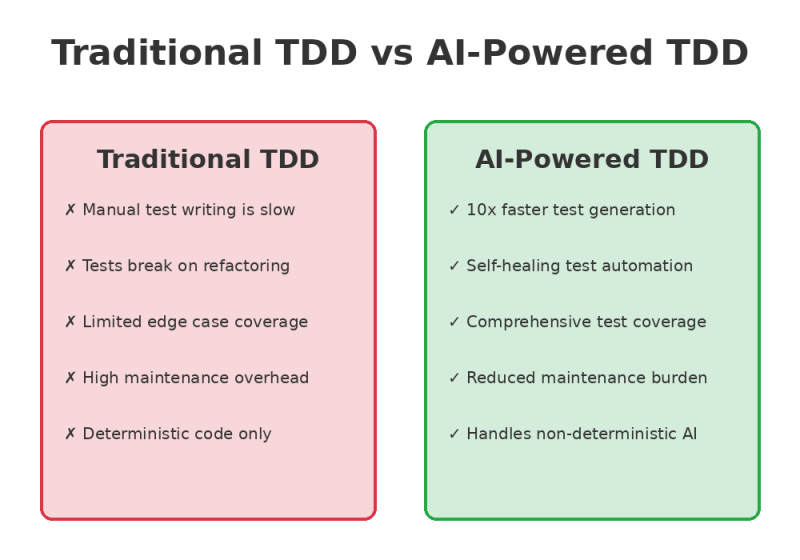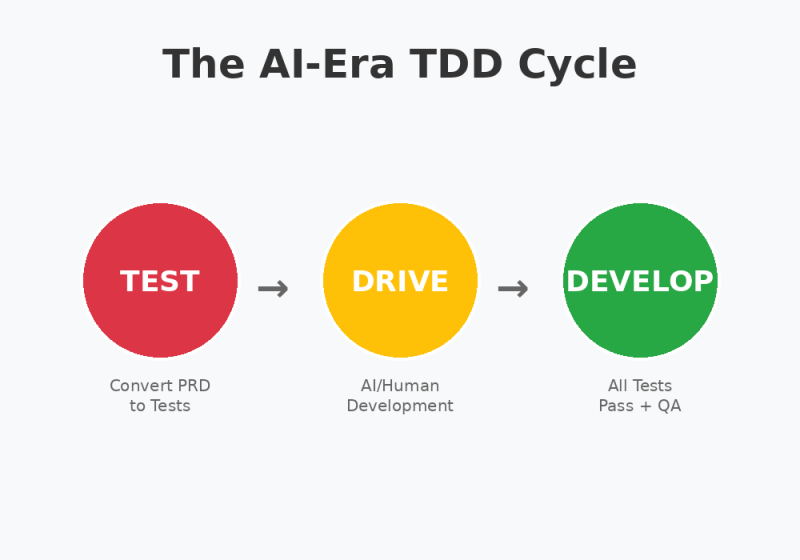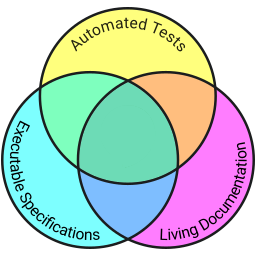TDD & BDD in the Age of AI: Why AI Agents Demand 100% More Test-First Development
The software development landscape has fundamentally transformed. AI agents aren't just writing code; they are becoming primary developers on our teams. This paradigm shift demands a radical rethinking of how testing is approached. Test-Driven Development (TDD) and Behavior-Driven Development (BDD), once considered optional best practices, have become mission-critical disciplines in the age of AI-powered development.
The stakes have never been higher. Studies show that 60-80% of software development costs stem from rework, and effective requirements management can eliminate 50-80% of project defects. With AI agents generating code at unprecedented speeds, the cost of getting requirements wrong multiplies exponentially. TDD and BDD provide the guardrails that keep AI development on track.
Why AI Agents Make TDD Non-Negotiable

The Non-Deterministic Problem
AI-driven development introduces a fundamental challenge: non-determinism. Unlike traditional development where the same input produces the same output, AI agents can generate vastly different code solutions for identical prompts. This variability, while enabling creative problem-solving, creates a quality control nightmare without proper testing infrastructure.
As Eric Elliott notes in his work on AI-Driven Development: "AIDD is non-deterministic, and different prompts can lead to radically different outputs. This is a good thing because it allows you to explore different approaches to the same problem to find the best solution. However, it can also be a challenge to ensure that the generated code is correct."
Fast Feedback Loops as Safety Nets
TDD provides deterministic exit criteria for AI agents. Instead of relying on the AI's judgment about when code is "done," tests force agents to iterate until all requirements pass. This creates a continuous feedback loop where tests guide the AI toward correct implementations, catching hallucinations and logical errors before they compound.
Simon Willison, a prominent voice in AI development, emphasizes: "Tests give us reliable exit criteria. We are not relying on AI agent's whims, but we force it to iterate until the previously failed tests pass."
The AI-Era TDD Framework: Test → Drive → Develop

The traditional Red-Green-Refactor cycle of TDD has evolved for the AI age. Here's the new paradigm that makes AI agents productive and trustworthy:
- TEST: Convert PRD to Automated Acceptance Tests First
- Draft tests from PRD specifications: AI agents excel at converting natural language requirements into test scaffolds. Given a PRD section like "User login must support 2FA," AI can generate comprehensive test cases covering happy paths, edge cases, and error conditions.
- Human refinement: Developers and QA engineers review AI-generated tests for completeness, business logic accuracy, and security considerations that AI might miss.
- Use Given-When-Then format: Write acceptance criteria in BDD style for clarity.
- DRIVE: The Development Process from Tests
- AI agents receive test suites as their primary input, rather than vague prompts.
- Iterative refinement by AI with tools like Cursor, Claude Code, and GitHub Copilot to execute this loop autonomously.
- Self-healing capabilities: Advanced agents automatically update tests to match UI changes.
- DEVELOP: Stop When All Tests Pass
- Automated unit tests: Verify individual function correctness and business logic.
- Functional acceptance tests: Validate end-to-end user flows and system integration.
- Visual regression tests: AI-powered tools catch UI inconsistencies using computer vision.
- Human QA/QC sign-off: Final validation of user experience and edge cases by human QA.
BDD: From Broken Promise to AI-Powered Reality
The Historical Challenge
Behavior-Driven Development promised a common language uniting product, development, and QA teams. In practice, it often devolved into a siloed QA activity. Writing Gherkin scenarios required technical expertise, maintaining step definitions became burdensome, and the collaboration benefits never materialized.
AI Changes Everything
AI removes the technical barriers that held BDD back. Product managers can now write scenarios in natural language, and AI translates them into executable tests automatically. The "three amigos" collaboration (product, dev, QA) can finally happen without technical gatekeeping.
- Natural language to tests: AI can generate complete test suites from plain English scenarios with high accuracy.
- Semantic understanding: AI-powered test runners locate UI elements by context rather than brittle CSS selectors.
- Living documentation: BDD scenarios serve as always-current documentation that both executes and documents system behavior.
Implementing AI-Powered TDD/BDD: A Practical Guide
Phase 1: Foundation Setup
- Choose Your Testing Framework
- Unit Testing: Jest, Pytest, JUnit
- BDD Testing: Cucumber, SpecFlow, Behave
- Visual Testing: Percy, Applitools, Chromatic
- E2E Testing: Playwright, Cypress
- Integrate AI Tools
- Use AI coding assistants like Cursor, Claude Code, or GitHub Copilot.
- Configure AI agents with context about your testing frameworks and conventions.
- Set up CI/CD pipelines to run tests automatically on every commit.
Phase 2: The TDD Workflow
- Step 1: From PRD to Tests
- Example: Building a shopping cart feature
- Step 2: Human Review & Refinement
- Ensure business logic accuracy, security considerations, edge cases, and performance benchmarks.
- Step 3: AI Implementation
- Prompt AI to implement features and iterate until tests pass.
- Step 4: Continuous Validation
- Includes automated test suite execution, visual regression comparisons, performance benchmarking, and more.
Measuring Success: The Impact of AI-Powered TDD
The Data Speaks
Research and industry reports reveal compelling evidence for test-first development with AI:
- Defect Reduction
- TDD produces 40-80% fewer bugs compared to test-after development.
- AI-powered TDD catches regressions at commit time, keeping main branches reliably releasable.
- Development Speed
- AI can generate test suites 10x faster than manual writing.
- Team Productivity
- Developers spend less time debugging and more time creating features.
Avoiding Common Pitfalls
While AI-powered TDD/BDD offers tremendous benefits, teams often encounter these challenges:
- Pitfall 1: Over-Trusting AI-Generated Tests
- Solution: Always have experienced developers review AI-generated tests.
- Pitfall 2: Testing Implementation Instead of Behavior
- Solution: Focus tests on observable behavior and outcomes.
- Pitfall 3: Skipping the Human Review Cycle
- Solution: Human QA must validate user experience, accessibility, and scenarios.
- Pitfall 4: Neglecting Test Maintenance
- Solution: Use AI's self-healing capabilities to automatically update tests when changes occur.
The AI-TDD Ecosystem: Essential Tools
- AI Coding Assistants
- Cursor
- Claude Code
- GitHub Copilot
- BDD Frameworks
- Cucumber
- SpecFlow
- Behave
- Visual Testing Platforms
- Percy (BrowserStack)
- Applitools
- Chromatic
- Test Automation Platforms
- Playwright
- Cypress
- TestRigor
- AI Testing Platforms
- Functionize
- Momentic
- Agentforce Testing Center
The Future Is Test-First
The convergence of AI agents and test-driven development represents a fundamental shift in how software is built. TDD and BDD are no longer optional best practices; they're essential disciplines for harnessing AI's power while maintaining quality and reliability.
Key Takeaways:
- AI's non-determinism makes tests essential.
- Test → Drive → Develop process: Convert PRDs to tests first, use tests to drive development.
- BDD's promise realized: AI removes technical barriers, making BDD accessible.
- Automation at scale: AI can generate and maintain tests faster, but human judgment is critical.
- Comprehensive coverage: Combine unit tests, functional tests, visual regression tests, and human QA.
As Kent Beck stated: "Clean code that works is the goal. TDD is merely the discipline that gets us there." In the age of AI, that discipline has never been more vital. By embracing test-first development, AI's potential is unlocked while maintaining the quality, reliability, and trust that modern software demands.
Getting Started
- Start small: Choose one feature and use AI assistance for test-first development.
- Invest in training: Ensure the team understands TDD principles and AI tool capabilities.
- Build incrementally: Add test automation to CI/CD pipeline piece by piece.
- Measure impact: Track defect rates, development velocity, and team satisfaction.
- Iterate: Refine processes based on team and domain needs.

The future of software development is test-first. The tools are here. The benefits are proven. The time to act is now.
It is no longer like

It is more like more circles



